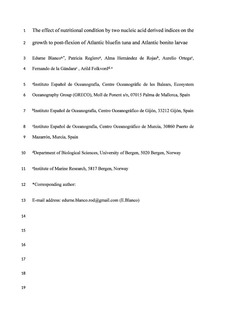| dc.description.abstract | Notochord flexion increases the swimming capacity of fish larvae, aids in the capture of mobile prey, and coincides with the timing of when the physiological capacities of larvae begin to develop significantly, allowing an early shift to piscivory. Therefore, reaching the flexion stage as soon as possible can be considered beneficial for the growth and survival of the larvae. Individual growth differences of larvae from the same cohort are very common before reaching flexion and the potential explanation is still unknown. In this study, we examined if the nutritional status of the larvae, measured by the RNA:DNA and DNA:DW ratios, explains the differences in the development of notochord flexion in laboratory-reared Atlantic bluefin tuna (ABFT; Thunnus thynnus) and Atlantic bonito (AB; Sarda sarda) larvae. Moreover, we described the ontogeny of the different stages and condition indices. The daily average condition of ABFT estimated by the RNA:DNA and DNA:DW ratios increased with larval age and developmental stage, whereas in AB it was not. In both species, bigger larvae at a specific age had higher nutritional condition than smaller larvae regardless of developmental stage. However, in ABFT the DNA:DW ratio indicated lower condition for the biggest larvae within developmental stages F0 (pre-flexion) and F3 (post-flexion). After removing the size effect, larger individuals of ABFT within flexion stages F1 and F2 had higher condition than any other larval stages, whereas in AB an indistinct trend within stages was found. Our results confirm that in ABFT the RNA:DNA ratio is correlated with faster development while the DNA:DW ratio is negatively correlated with the time to flexion. The trends found in the DNA:DW ratio points at cell growth mechanisms being a better indicator of larval condition that the RNA:DNA ratio. Our findings suggest that under culture, ad libitum conditions, larval nutritional conditions measured by nucleic acid ratios, might not be enough to explain developmental differences in fast growing species. | nb_NO |
